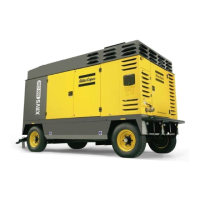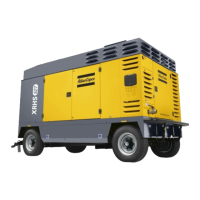Instruction Manual
2954 2510 03 27
2.4.3 Oil system
The lower part of the air receiver (AR) serves as oil tank.
Air pressure forces the oil from the air receiver/oil separator (AR/OS) through the oil cooler (OC), the
oil filters (OF) and the oil stop valve (OSV) to the compressor element (CEhp CElp).
When the compressor is stopped and / or there is no pressure in the system, the oil stop valve
(OSV) prevents the oil from flowing back into the compressor element.
The thermostatic by-pass valve (TBV) starts opening when the oil temperature is 80 °C (176 °F)
(when no Oiltronix is installed). With installed Oiltronix, the thermostatic by-pass valve starts
opening when the oil temperature is 40 °C (104 °F).
The compressor element has an oil gallery in the bottom of its casing. The oil for rotor lubrication,
cooling and sealing is injected through holes in the gallery.
Lubrication of the bearings is ensured by oil injected into the bearing housings.
The injected oil, mixed with the compressed air, leaves the compressor element and re-enters the air
receiver, where it is separated from the air as described in section 2.4.2 Air flow. The oil that
collects in the bottom of the oil separator element is returned to the system through a scavenging
line (SL), which is provided with a flow restrictor (FR).
The oil filter by-pass valve opens when the pressure drop over the filter is above normal because of
a clogged filter. The oil then by-passes the filter without being filtered. For this reason, the oil filter
must be replaced at regular intervals (see section 4.5 Preventive maintenance schedule for the
compressor).
2.4.4 Continuous regulating system
The compressor is provided with a continuous regulating system and a blow-off valve (BOV) which
is integrated in the unloader assembly (UA). The valve is closed during operation by outlet pressure
of the compressor element and opens by air receiver pressure when the compressor is stopped.
When the air consumption increases, the air receiver pressure will decrease and vice versa. This
receiver pressure variation is sensed by the regulating valve (RV) which, by means of control air to
the unloader assembly (UA), matches the air output to the air consumption. The air receiver
pressure is maintained between the pre-selected working pressure and the corresponding unloading
pressure.
When starting the compressor, the throttle valve (TV) is kept closed via receiver pressure. The
compressor element (CEhp CElp) takes in air and pressure builds up in the receiver (AR). The throttle
valve (TV) is closed. The air output is controlled from maximum output (100%) to no output (0%)
by:
1 Speed control of the engine between maximum load speed and unloading speed (the output of a
screw compressor is proportional to the rotating speed).
2 Air inlet throttling.
If the air consumption is equal to or exceeds the maximum air output, the engine speed is held at
maximum load speed and the throttle valve (TV) is fully open.
If the air consumption is less than the maximum air output, air receiver pressure increases and the
regulating valve supplies control air to throttle valve (TV) to reduce the air output and holds air
receiver pressure between the normal working pressure and the corresponding unloading pressure.
Unloading pressure = normal working pressure + 1 bar (14.504 psi).
When the air consumption is resumed, the blow off valve (BOV) closes and the throttle valve (TV)
gradually opens the air intake and the electronic speed regulator increases the engine speed.
The construction of the regulating valve (RV) is such that any increase (decrease) of the air receiver
pressure above the pre-set valve opening pressure results in a proportional increase (decrease) of
the control pressure to the throttle valve and the electronic speed regulator.
Part of the control air is vented to atmosphere, and any condensate discharged, through the vent
holes (VH).

